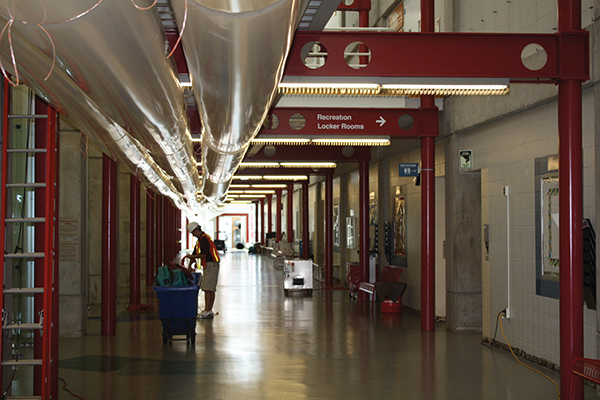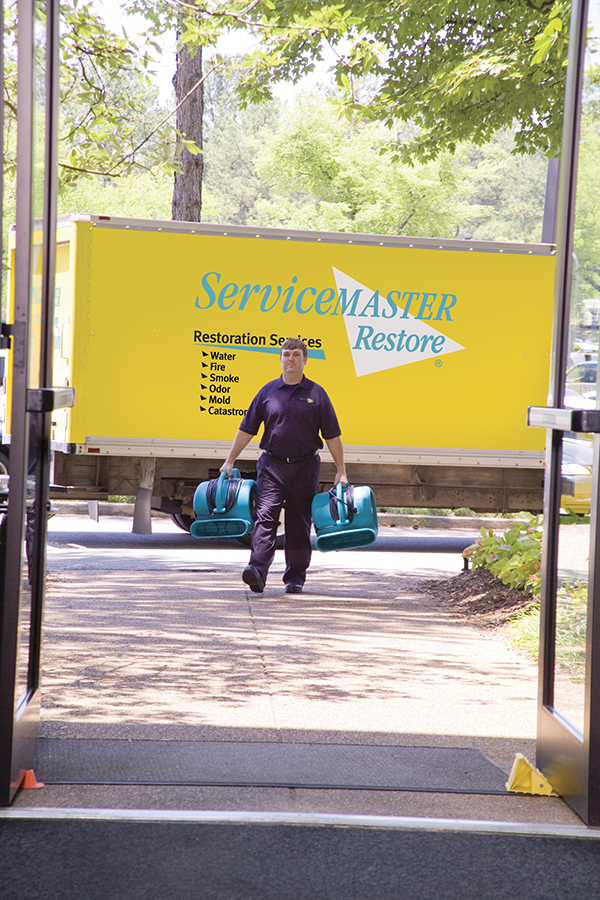While it is true that water damage is most often caused by huge storms and flooding, there are many other factors that can result in a water problem as well. In fact, seemingly minor issues like small leaks have been found to cause much greater damage than natural disasters, as they happen more frequently and usually remain unnoticed for a long time.
Water leaks pose a very significant threat to commercial buildings, in particular, as they use much bigger amounts of water than residences – either for their business activities or simply because of the large number of people using the water fixtures in the facility on a daily basis. Therefore, leaks in a commercial building lead to the waste of hundreds of gallons of water per day and can substantially increase the company’s monthly bills. What’s more, some plumbing leaks can cause severe water damage to the building and necessitate expensive repairs.
To avoid such troubles, property owners need to maintain their buildings in excellent condition and seek efficient professional solutions at the first sign of a water problem.
Common Leaks in Commercial Buildings
To be able to fix minor problems before they have the chance to cause significant water damage to your commercial facility, you need to be familiar with the most common types of leaks found in commercial buildings and their telltale signs.
Toilet leaks
Toilets in commercial buildings (especially ones with public restrooms) get A LOT of use. Their parts wear quickly and may allow water leaks to occur. For example, a flapper that doesn’t create a solid seal will allow water to leak from the toilet tank drain and a fill valve that doesn’t shut off when the toilet tank is refilled will continue to send water into the tank.
A leaking toilet doesn’t seem to be a big problem – the malfunctioning parts are easy to replace and not very expensive. If the leak is neglected, however, it can lead to substantial long-term water loss, increased water bills, and damage to other toilet components, so you may eventually need to replace the entire toilet in order to get rid of the problem.
Faucet leaks
 Leaky faucets are another common and generally neglected issue in a commercial building. Similarly to leaking toilets, they’re usually the result of a worn or damaged component. If the rubber washers used to create a watertight seal in the faucet, for example, wear out, the seal will fail and the faucet will leak. This will result in an extensive water loss (and higher water bills) and will affect other faucet components over time. In the end, you’ll have little choice but to replace the entire faucet fixture.
Leaky faucets are another common and generally neglected issue in a commercial building. Similarly to leaking toilets, they’re usually the result of a worn or damaged component. If the rubber washers used to create a watertight seal in the faucet, for example, wear out, the seal will fail and the faucet will leak. This will result in an extensive water loss (and higher water bills) and will affect other faucet components over time. In the end, you’ll have little choice but to replace the entire faucet fixture.
Ceiling leaks from bathrooms on the upper floors
Leakages in bathrooms and other wet areas of high-rise buildings are most often due to failure of the waterproofing membrane. A low quality or damaged waterproofing membrane will quickly lead to dampness and seepage inside the building, as the water from the bathroom floor will be able to easily make its way across the porous concrete slab beneath. Dampness patches will appear on the ceiling on the lower floor and unless quick and efficient measures are taken to fix the problem, the dripping water will result in mold growth and structural damage. Repairing the damage will take plenty of time and effort and the cost will be high.
Plumbing leaks
Needless to say, broken water supply pipes and deteriorated sewer lines are the most common cause for water damage in a building. Water pipes can easily burst in cold weather and sewer drains may deteriorate over time, causing extensive water leaks and severe water damage. To make matters worse, the piping systems and sewer lines are most often buried underground or located inside walls, so it is very hard to detect the leak and find the leaking pipe. If the leakage remains unnoticed or unattended for a long time though, it can create unexpected flooding or long-term water damage that is very expensive and difficult to repair.
So, you need to watch out for the first signs of a pipe leak and act quickly to fix the problem before it has become too late:
- ⋅ The most common signs of underground plumbing leaks include areas of wet soil, areas where grass or other plants are growing faster than in the surrounding areas, and unstable, spongy floors;
- ⋅ Bulging walls, crumbling plaster, blistering paint, water stains, cracked or loose tiles and gaps in the grout are tell-tale signs of leaking pipes in the walls;
- ⋅ Musty smells, visible mold patches, and unexplainable rises in water bills are also clear indications of hidden water leaks.
To locate the source of a pipe leak, you’re going to need specialized water leak detection equipment. Once found, the damaged pipes have to be dug up in order to be repaired – it may be necessary to displace soil or remove floorings, insulation, and other materials to get access to the leak. The repairs are likely to be expensive and time-consuming and oftentimes mold remediation and other specialized restoration procedures may be required to avert long-term problems from the leak.
Basement leaks
 Leakages in basements can be attributed to many factors – poor waterproofing systems, inferior concrete quality, defects or damage to the waterproofing membrane, insufficient slope, and others. Such waterproofing failures allow seepage from clogged drainage, broken pipes, ground water level rise, and even water features of the above ground landscaping (swimming pools, upper floor wet areas, etc.) which can lead to water damage in the basement.
Leakages in basements can be attributed to many factors – poor waterproofing systems, inferior concrete quality, defects or damage to the waterproofing membrane, insufficient slope, and others. Such waterproofing failures allow seepage from clogged drainage, broken pipes, ground water level rise, and even water features of the above ground landscaping (swimming pools, upper floor wet areas, etc.) which can lead to water damage in the basement.
The structural integrity of the basement will be seriously compromised by the high moisture level, as the chloride content of the concrete will rise above the threshold level resulting in severe corrosion problems.
Roof leaks
A leaky roof is a serious structural problem that poses a number of safety risks and can easily result in significant commercial water damage. There are many possible causes of a commercial building roof leak:
- ⋅ The roof may be damaged by hail, high winds, torrential rains, heavy snowfall, etc. – shingles can get damaged or blown away in strong storms, allowing water to enter the building;
- ⋅ The roofing materials may not be appropriate or may be improperly installed or they may wear down with time;
- ⋅ The flashing may be improperly installed or missing – if the metal installed around the roof edges, chimneys, dormer windows, skylights, and/or vent pipes breaks or becomes loose due to wind or storms, the edges of the roof membrane cover remain exposed, allowing moisture and water to seep into the roofing system and the building;
- ⋅ The valleys (the places where two roof planes come together) may not be sealed well, allowing rainwater to get through them as it runs down the roof;
- ⋅ Pipes, drains, and other items that puncture the roof’s membrane may not be secured properly, opening a way for rainwater into the building;
- ⋅ The skylights may be improperly installed or the insulation along the skylights’ edges may decay over time, allowing water to leak inside;
- ⋅ Ice dams (ridges of ice at the roof edges) may form and prevent melting snow from draining off – the blocked water may back up and find its way into the building;
- ⋅ The gutters may get clogged, preventing rainwater from draining away, so it pools in one area of the roof. Pooling water can add significant strain to the roofing system (one square foot of pooling water weighs roughly 5 pounds per inch of water) and cause substantial water damage to the commercial building;
- ⋅ The commercial roofing system may be too old (most flat roofs start to deteriorate about 15-20 years after installation) and become vulnerable to water damage.
The most common signs of roof leaks include:
- ⋅ Water spots, damp patches, rust stains, or discolored areas on ceilings and walls;
- ⋅ Peeling paint around skylights or dormer windows;
- ⋅ Decaying or stained soffits and fascia;
- ⋅ Granules collecting in the gutters;
- ⋅ Curling or cupping shingles;
- ⋅ Decreased energy efficiency of the building;
- ⋅ Deteriorated indoor air quality;
- ⋅ Musty smell in the upper floors;
- ⋅ Mold on attic insulation, ceilings, etc.;
- ⋅ Water seeping into the building during heavy rainfall or when the snow is melting.
Consistent leaks from the roof can initiate corrosion of the reinforcement causing concrete spalling that may lead to a soffit collapse. The repairs will cost a lot and will most likely necessitate the shutdown of all activities in the building for the duration of the restoration process.
Balcony leaks
The aggressive effects of the elements on external balconies – an integral part of multi-story commercial buildings – make them very vulnerable to damage and turn them into one of the most common sources of water leaks in a commercial facility. Various factors such as severe weather conditions, air borne salts, atmospheric carbon dioxide, high humidity, and temperature fluctuations can result in balcony leakage due to failure of the waterproofing membrane, inadequate drain slope, or poor design of the balconies.
If left unattended, the affected balconies present a danger both to the structural integrity of the building (water leaks in balconies can easily trigger an electrochemical corrosion process resulting in damage and spalled concrete) and to the safety of the occupants.
How to Detect Plumbing Leaks in a Commercial Building
 To prevent such trouble, protect your investment, reduce repair and remediation expenses, and decrease the chance of hidden, long-lasting consequences, you need to detect water leaks as quickly as possible and address them without delay.
To prevent such trouble, protect your investment, reduce repair and remediation expenses, and decrease the chance of hidden, long-lasting consequences, you need to detect water leaks as quickly as possible and address them without delay.
The latest advancements in water leak sensing and shut-off technology make it easy to catch a leak at its source and fix the problem before it has become too late. Installing a leak detection system in a commercial building is extremely beneficial, as it allows for the early detection of water leaks and the prevention of water damage. An integrated automatic water leak system will alert the building management to the precise location of a leak, within minutes of detection (water sensors are working 24/7 to detect water leaks and send an alert as soon as they sense water):
- ⋅ Wireless water leak detectors – The building is retrofitted with wireless sensors that respond with a local alarm and deliver notifications by phone, text and email to the building managers when a leak occurs;
- ⋅ Cloud-based sensors – Cloud-based sensors are placed at sites of potential leaks – sinks, toilets, basements, plumbing chases, etc. – and can combine data from all units into a single portal that is monitored by the building operators;
- ⋅ Automated sensors – These advanced water leak sensors automatically shut off water in certain applications when a leak is detected.
Well-designed water leak detection equipment is easy to install, very affordable, and highly efficient. It ensures business continuity and helps avoid costly repairs.
What to Do When You Find a Leak in Your Commercial Building
It is of paramount importance to seek prompt professional solutions at the first sign of water leakage in your commercial building – the experts will take quick and efficient measures to fix the problem and will prevent water damage to your property and large scale, expensive repairs.
ServiceMaster Water Damage Services for Businesses – Watch the Video
If you find a water leak in your commercial building in Alexandria, VA, or the Washington, D.C., metro area, immediately contact ServiceMaster NCR at (855) 957-6627 – we’re available 24/7/365 to help you find an efficient solution to your water problem. Our commercial water damage restoration services include an emergency response to limit the spread of water, water extraction and drying services with professional-grade equipment and procedures, restoration of affected belongings (including delicate electronics), and repair of damaged building materials and components. You will be able to get your business back on track quickly and will avoid greater troubles and costly damage.













